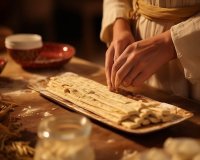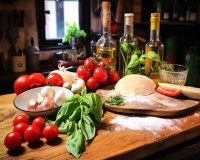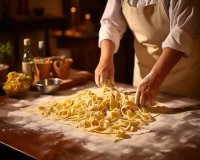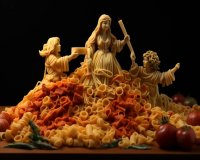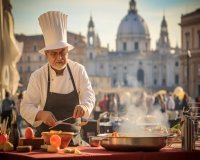Unraveling the Secrets of Piazza Navona’s Pasta Making
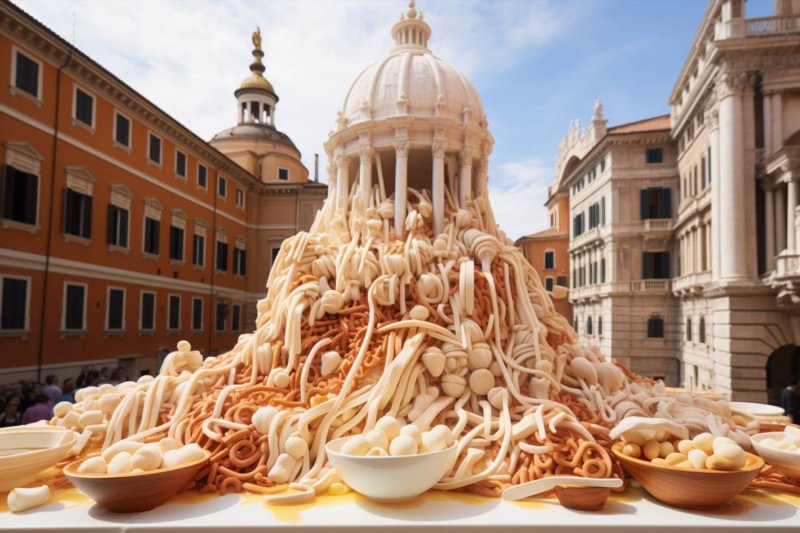
Unraveling the Secrets of Piazza Navona’s Pasta Making in Rome
Welcome to the heart of Rome, where history, culture, and culinary traditions converge to create a unique experience. Piazza Navona, a stunning square that has witnessed centuries of Roman life, is not only a sightseeing wonder but also a haven for food enthusiasts. In particular, it's renowned for its pasta-making heritage that is as rich and diverse as the city's own history.
A Culinary Journey Through History
Before we dive into the secrets of Piazza Navona's pasta-making, let's explore the historical backdrop that shapes this culinary tradition. Rome, with its ancient origins dating back to 753 BC, boasts a culinary history that is nothing short of spectacular. Pasta, which is an integral part of Italian cuisine, has played a significant role in shaping the city's culinary identity.
Pasta in Rome: More than Just Spaghetti
While spaghetti is undeniably popular, Roman pasta goes beyond this iconic dish. In Piazza Navona, you can discover a wide array of pasta types, from the beloved carbonara to the rich and creamy cacio e pepe. Each dish is a testament to the city's culinary diversity, and these recipes have been passed down through generations, preserving the essence of Roman cuisine.
The Ingredients Matter
The secret to Rome's delectable pasta lies in its ingredients. Fresh, high-quality produce is the foundation of any great dish. The pasta itself, made from durum wheat semolina, is expertly crafted to achieve the perfect texture, whether it's the al dente goodness of spaghetti or the smoothness of fettuccine. It's all about the combination of simplicity and precision.
The Art of Sauces
Roman pasta would be incomplete without its incredible sauces. The world-famous carbonara is a blend of eggs, Pecorino Romano cheese, guanciale (cured pork jowl), and black pepper. Cacio e pepe, on the other hand, showcases the magic of Pecorino Romano, black pepper, and pasta water. These sauces might seem simple, but perfecting them is an art that takes years of experience.
The Craft of Pasta-Making
Pasta-making in Piazza Navona is not just a culinary tradition; it's an art form. Skilled pasta artisans meticulously roll, cut, and shape the dough into various forms, ensuring that every piece is a work of art. The hands that knead the dough have inherited the wisdom of generations past, allowing them to create pasta that's both exquisite and delicious.
Sharing the Secrets
While the secrets of pasta-making are closely guarded, Piazza Navona welcomes visitors to learn from the masters. There are cooking classes and workshops where you can roll up your sleeves, don an apron, and try your hand at crafting the perfect Roman pasta. It's an experience that not only allows you to savor the results but also to carry a piece of Rome's culinary heritage with you.
Embracing the Roman Way of Life
As you indulge in the delightful pasta dishes of Piazza Navona, you'll come to appreciate that the secret ingredient is the Roman way of life itself. Slow-paced, full of zest, and rich in tradition, this is a city that takes its food seriously. Whether you're dining in a charming trattoria, a rustic osteria, or a modern ristorante, you're sure to find the heart and soul of Rome in every bite.
In Conclusion
Piazza Navona's pasta-making tradition is a culinary journey through history, an exploration of flavors, and a celebration of the Roman way of life. It's a reflection of the city's rich past and a testament to its enduring traditions. So, when in Rome, do as the Romans do – embrace the pasta-making secrets of Piazza Navona and savor the incredible taste of this timeless tradition.
Rome: Dive into Italian Culinary Delights
When in Rome, do as the Romans do—especially when it comes to savoring the culinary wonders of the city. Step away from the traditional tourist path and embark on a journey into the heart of Italian gastronomy with our captivating cooking class.
Led by a skilled English-speaking chef, this immersive experience isn't just about crafting a meal; it's a culinary adventure. Begin your day at a bustling local market, a sensory explosion of vibrant colors and enticing aromas. Immerse yourself in the atmosphere as you, like a seasoned local, select the freshest ingredients for your upcoming culinary masterpiece.
Guided by your expert chef, you'll navigate the market's rich tapestry, ensuring you choose the finest produce for your traditional Italian feast. The market excursion is not just a prelude; it's an integral part of the journey, providing a genuine taste of Roman daily life.
After the market, a short jaunt leads you to our culinary haven. Welcomed with a Prosecco and antipasti reception, you'll transition seamlessly into the heart of the Eternal City's culinary scene. Our cooking class venue, strategically located near Piazza Navona, sets the stage for an unforgettable gastronomic experience.
Embark on a culinary voyage, mastering the art of crafting a delightful 4-course Italian meal. From pasta to prosecco, every step is curated by your expert guide, ensuring not just a meal but a memorable journey into the soul of Italian cuisine.
Experience Highlights:
- Farmers' Market immersion for ingredient selection
- Guidance from an English-speaking chef
- Prosecco and antipasti reception
- All necessary ingredients and equipment provided
- Craft and savor your homemade meal with complimentary drinks
Uncover the secrets of Italian cooking, and leave with more than just a full stomach—take home the skills to recreate the magic in your kitchen. Book your spot now and become a maestro of authentic Italian cuisine!
The Art and Craft of Pasta Making in Rome
Rome, the eternal city, is not only famous for its rich history and iconic landmarks but also for its culinary delights. Among the many delectable dishes that have their origins in the heart of Italy, pasta holds a special place. Pasta making in Rome is not just a culinary skill; it's an art and craft that has been perfected over centuries.
When you think of Italian cuisine, pasta is likely one of the first things that come to mind. It's a staple in Italian households and an integral part of Roman cuisine. The art of pasta making in Rome is a tradition that has been passed down from one generation to the next, with each family holding its closely guarded secrets and techniques.
The Ingredients
At the core of pasta making are the ingredients. Roman pasta is simple, yet its quality is unparalleled. The essential components include durum wheat semolina, water, and sometimes eggs. The choice of wheat is crucial as it determines the texture and flavor of the pasta.
The Craft of Making Pasta Dough
The magic of Roman pasta begins with the dough. To make the perfect pasta dough, you need to mix the semolina with water or eggs until a firm, smooth, and elastic dough is formed. The dough is then kneaded to activate the gluten and develop its texture. This is where the craft comes into play; experienced pasta makers know just the right amount of kneading and when to stop to achieve that perfect consistency.
The Pasta Shapes
Roman pasta makers are known for their creativity in crafting various shapes of pasta. From the iconic spaghetti to the delightful rigatoni, there's a shape for every sauce and occasion. Each shape has its unique method of preparation, which has been handed down through generations.
| Pasta Shape |
Best Suited Sauce |
| Spaghetti |
Carbonara, Cacio e Pepe |
| Rigatoni |
Amatriciana |
| Fettuccine |
Alfredo, Pesto |
The Cooking Process
Cooking pasta in Rome is an art in itself. The pasta is cooked 'al dente,' which means it's firm to the bite. Overcooking is a cardinal sin in Roman pasta making. The pasta is then tossed with various sauces, ranging from the classic tomato-based sauces to creamy indulgences.
The Sauces
Rome boasts a rich variety of pasta sauces. While you might think of pasta with tomato sauce as the quintessential Roman dish, there are many more to explore. Cacio e Pepe, a simple yet divine combination of Pecorino cheese and black pepper, is a Roman specialty. Carbonara, with its creamy egg and pancetta sauce, is another must-try.
The Art of Presentation
Roman pasta isn't just about taste; it's also about presentation. Pasta dishes are often garnished with fresh herbs, grated cheese, or a drizzle of extra virgin olive oil to enhance both the flavor and visual appeal.
In conclusion, the art and craft of pasta making in Rome are deeply ingrained in the city's culture and history. From the choice of ingredients to the perfect pasta shape, every step in the process requires skill, tradition, and a deep love for the culinary heritage of Rome. When you savor a plate of Roman pasta, you're not just enjoying a meal; you're experiencing a piece of history and tradition that has been refined over centuries.
Lunchtime Pasta Cooking Class
Channel your inner pasta pro and transform into a Tiramisu Titan with just two hours of culinary brilliance! Enjoy a perfect lunch under the expert guidance of a renowned master chef.
About this activity
Free cancellation. Cancel up to 24 hours in advance for a full refund. Keep your travel plans flexible — book your spot and pay nothing today. Special health and safety measures are in place. Check your activity voucher once you book for full details.
Experience Highlights
- Learn to make Italian Pasta & Tiramisu
- Local expert and fun chef
- Eat what you make
- Take your recipes home
Full description
Unleash your culinary creativity and acquire mastery in the art of crafting perfect pasta and exquisite tiramisu within a compact two-hour timeframe, under the expert guidance of a celebrated and highly skilled chef.
Immerse yourself in an exceptional gastronomic experience where mediocrity is not an option. Prepare to delve into the realm of pasta wizardry, where you will not only concoct three extraordinary pasta varieties but also venture into the realm of vibrant and stuffed pasta creations that will captivate your taste buds and transport you to the very heart of Italian cuisine.
Yet, the offerings extend beyond pasta. Prepare to embark on a journey that will transport your palate directly to the vibrant landscapes of Italy, as you master the creation of authentic carbonara and cacio e pepe dishes. These culinary creations are sure to elicit a symphony of flavors that will leave your loved ones yearning for the elusive secrets behind your recipes.
Of course, no culinary exploration of Italian cuisine would be complete without indulging in the undisputed champion of Italian desserts: tiramisu. Immerse yourself in the tantalizing world of this delicacy and uncover the enigmatic techniques behind the perfect fusion of flavors that will leave you and your guests spellbound, uttering the phrase "Bellissimo!"
This experience, however, encompasses more than the mere pleasure of savoring delectable treats. As you embark on this culinary adventure, you will also acquire a treasure trove of invaluable knowledge. Return home not only with cherished memories but also armed with timeless Italian culinary expertise, solidifying your standing as a legendary figure within your own kitchen, capable of crafting extraordinary dishes for years to come.
So, don your culinary attire, grasp your utensils firmly, and prepare to be swept away by a whirlwind of epicurean delights. Seize this unique opportunity to unlock your inner pasta Picasso and become an esteemed Tiramisu Titan, all within a singular and remarkable experience.
Includes
Local Pasta Chef and Host, Cooking class, Cooking equipment, all ingredients, wine and drink.
Meeting point
Rome with Chef Cooking School
The Historical Roots of Pasta in Piazza Navona, Rome
Piazza Navona, one of the most iconic squares in Rome, is not only famous for its beautiful Baroque architecture and bustling atmosphere but also for its historical ties to one of the world's favorite foods - pasta. The history of pasta in Piazza Navona is a story that intertwines culture, tradition, and the love for Italian cuisine.
Pasta's Origins:
Pasta has a long and rich history that dates back centuries, and it's an integral part of Italian culture. Its origins can be traced to ancient civilizations such as the Etruscans and Greeks, who made various forms of pasta. However, it was the Romans who first documented a dish similar to what we now know as pasta. They used a simple mixture of water and wheat to create sheets of dough, which they cut into strips, similar to modern-day fettuccine or pappardelle.
Piazza Navona's Connection:
Piazza Navona, originally built as the Stadium of Domitian in the 1st century AD, has a history that goes back nearly two millennia. In the past, it was used for athletic competitions and events. During the Middle Ages, it was transformed into a bustling market square. This market square is where the story of pasta in Piazza Navona begins.
Local merchants and traders in the square, inspired by the Roman tradition of pasta, started to experiment with various shapes and types of pasta. This experimentation eventually led to the creation of pasta dishes that were not only delicious but also affordable and easy to prepare. Piazza Navona became a hub for the pasta trade in Rome, with merchants offering a wide variety of pasta to both locals and visitors.
The Pasta Revolution:
The 18th century brought a significant shift in the way pasta was consumed and prepared in Piazza Navona. The introduction of tomatoes from the New World transformed the Italian pasta landscape. Tomatoes made their way into pasta sauces, leading to the creation of iconic dishes like spaghetti with tomato sauce. Piazza Navona's eateries became renowned for their delectable pasta dishes, attracting food enthusiasts from near and far.
Pasta Today:
Today, Piazza Navona continues to be a culinary hub, with numerous restaurants and cafes serving a wide range of pasta dishes that pay homage to the historical roots of pasta in this square. From traditional Roman recipes like Cacio e Pepe and Carbonara to more modern interpretations, the pasta culture thrives in Piazza Navona.
Visitors can stroll through the square, taking in the grandeur of its fountains and architecture, and then enjoy a delicious plate of pasta in one of the charming restaurants that line the square. It's a testament to the enduring connection between pasta and this historic location.
In Conclusion:
Piazza Navona in Rome is not only a remarkable architectural wonder but also a place where the history of pasta has deep roots. The square's role in shaping the pasta culture of Rome, with its diverse pasta offerings and delicious recipes, has made it a must-visit destination for food enthusiasts and history buffs alike. So, the next time you find yourself in Piazza Navona, be sure to savor a plate of pasta and immerse yourself in the rich history that brought this delightful dish to life in this iconic Roman square.


